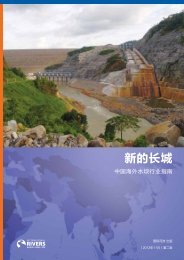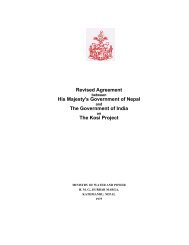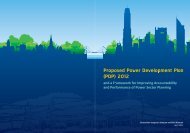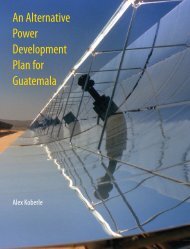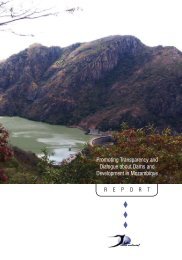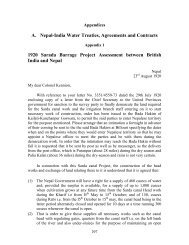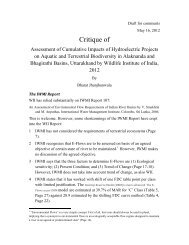Mountains of Concrete - International Rivers
Mountains of Concrete - International Rivers
Mountains of Concrete - International Rivers
Create successful ePaper yourself
Turn your PDF publications into a flip-book with our unique Google optimized e-Paper software.
Box 8: Some Likely Impacts <strong>of</strong> ClimateChange and Glacial Lake Outburst FloodRisks in Specific River BasinsBhutanTwenty-four lakes were identified as potentially dangerousbased on a set <strong>of</strong> criteria such as water level rise,the associated mother glacier, and the conditions <strong>of</strong> thedams and topographical features <strong>of</strong> the surroundings…Considering these criteria, five lakes in the Mo ChuSub-basin, eight lakes in Pho Chu Sub-basin, sevenlakes in the Mangde Chu Sub-basin, three lakes in theChamkhar Chu Sub-basin and one lake in the Kuri ChuSub-basin were identified as potentially dangerous. 1Nepal, Bhutan and TibetThe frequency <strong>of</strong> glacial lake outburst floods (GLOFs) inthe Himalayas <strong>of</strong> Nepal, Bhutan and Tibet has increasedfrom 0.38 events/yr in the 1950s to 0.54 events/yr inthe 1990s. 2PakistanWhile the science is still in its infancy, best estimatesare that there will be fifty years <strong>of</strong> glacial retreat, duringwhich time river flows will increase. This – especiallyin combination with the predicted flashier rainfall — islikely to exacerbate the already serious problems <strong>of</strong>flooding and draining, especially in the lower parts <strong>of</strong>the [Indus] basin, in the next few decades. But then theglacial reservoirs will be empty, and there are likely tobe dramatic decreases in river flows… conceivably by aterrifying 30% to 40% in the Indus basin in one hundredyears time. 31 Bajracharya, S. R., P. Mool and B.Shrestha: “Impact <strong>of</strong> Climate Changeon Himalayan Glaciers and Glacial lakes, Case Studies on GLOF andAssociated Hazards in Nepal and Bhutan,” 2007, ICIMOD and UNEP-ROAP, Kathmandu2 Bates, B.C., Z.W. Kundzewicz, S. Wu and J.P. Palutik<strong>of</strong>, Eds., 2008:Climate Change and Water. Technical Paper <strong>of</strong> the IntergovernmentalPanel on Climate Change, IPCC Secretariat, Geneva, 210 pp.Available at http://www.ipcc.ch/ipccreports/tp-climate-change-water.htm3 World Bank: “Pakistan: Country Water Resources Assistance Strategy,Water Economy: Running Dry November 14, 2005 Report No. 34081-PK,” 2005, South Asia Region, Agriculture and Rural Development Unit,South Asia Region, World Bankproblems are projected for regions which dependheavily on glacial melt water for their main dryseasonwater supply. 138Another cause for concern is the potential increase inthe sedimentation in the rivers due to climate change. Asit is, sedimentation is a severe problem in the rivers anddams in the Himalayas as these are young mountains anderosion rates are very high. The Warsak Dam in Pakistanis completely silted and the 21 MW Trishuli project inNepal barely generates 2 MW. 139 Climate change is likely toexacerbate the problem <strong>of</strong> high silt load in the rivers in threeways: 1. due to higher temperatures, a higher proportion<strong>of</strong> precipitation will fall as rain rather than snow, leadingto higher erosion; 2. as extreme events and intensities <strong>of</strong>precipitation increase, so will erosion; and 3. the melting <strong>of</strong>permafrost will also likely lead to increased erosion.Implications for Dam Building andAdaptationOne argument <strong>of</strong>ten presented is that since the variability<strong>of</strong> precipitation is likely to increase, an increase in storagecapacity is needed to smoothen out availability constraints.The argument is also presented in the context <strong>of</strong> possiblechanges in river flows: if flows are likely to increase, greaterstorage capacity is needed to take advantage <strong>of</strong> this; if flowsare likely to decrease, more storage to carry over occasionalhigh flows is needed. All this translates to a justificationfor building new big dams. However, this is an unsoundargument and is likely to result in disastrous consequences,all the more so in the Himalayan region.Creation <strong>of</strong> more storage as an answer to fluctuatingflows ignores the fact that climate change is going to increasethe threats to dam safety, including the risks <strong>of</strong> catastrophicevents like GLOFs. Hence, building more dams is likely to bea high risk policy choice. Indeed, given that the glacial meltfeed to the rivers is likely to decline over the longer term, thevery logic <strong>of</strong> building new and bigger dams is questionable,as they may not deliver the designed benefits. Building hugestorages to catch occasional high flows will be an expensivemeasure. This is in addition to the series <strong>of</strong> other problemsM o u n ta i n s o f C o n c r e t e : D a m B u i l d i n g i n t h e H i m a l aya s | 3 5








